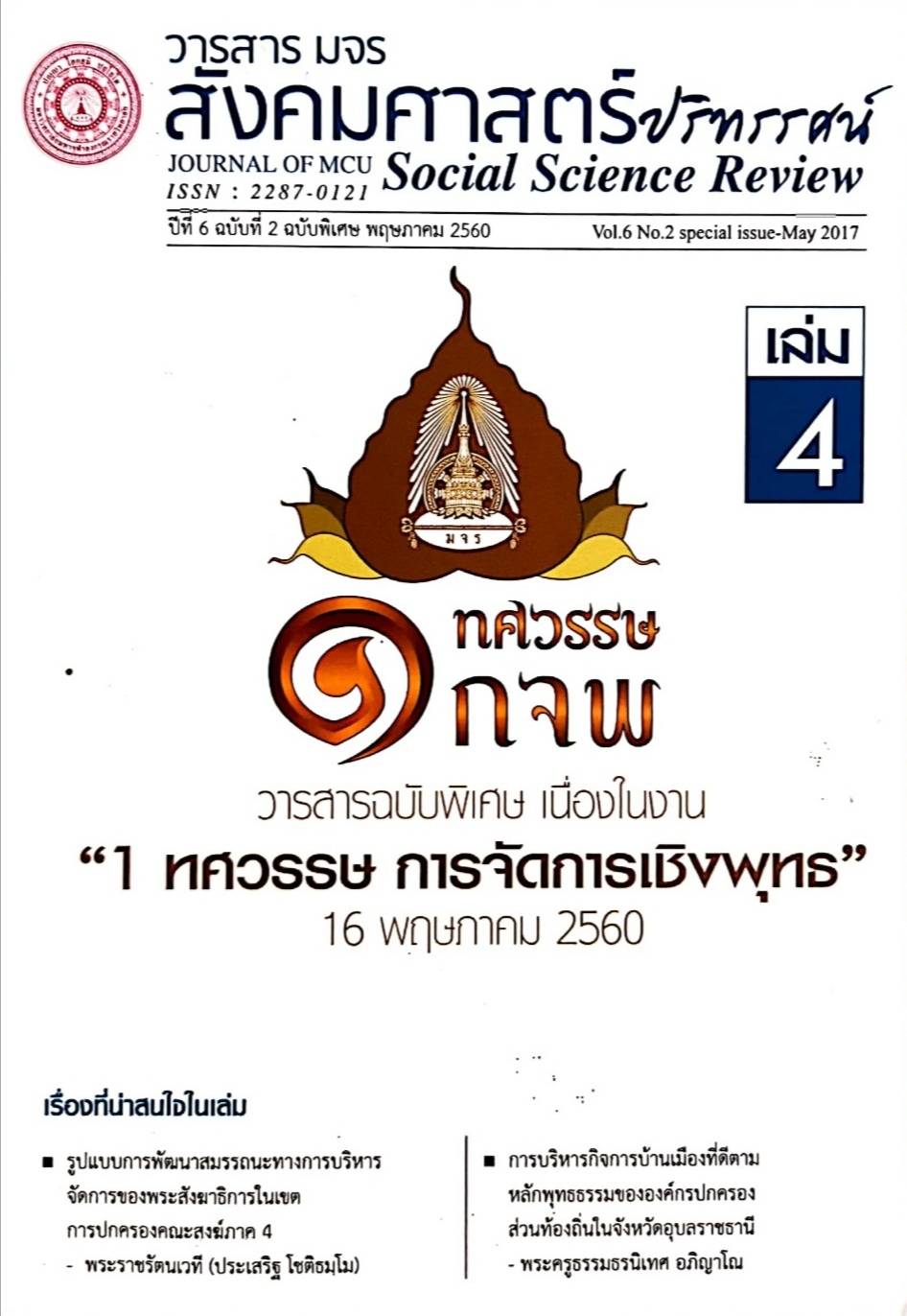THE MODEL OF TEMPLES DEVELOPMENT AS SPIRITUAL CENTER OF PEOPLE IN SARABURI PROVINCE
Keywords:
Model, Monastery Development, Spiritual CentersAbstract
The objectives of this research were: 1. To study general condition of
monastery development for people’s spiritual centers in Saraburi Province, 2. To
study principles and concepts of monastery development for people’s spiritualcenters in Saraburi Province and 3.To analyze a model of monastery development
for people’s spiritual centers in Saraburi province.
Methodology was the qualitative research collected data from 26 key
informants who were administrative monks, government officers, educational
institutes administrators, Buddhists in Saraburi Province and academicians of
Buddhism, purposefully selected with structured in-depth-interview form and from
10 participants in focus group discussion, analyzed data by descriptive
interpretation.
Findings were as follows:
1. General condition of monastery development for people’s spiritual
centers in Saraburi Province was that: personnel or administrative monk Factors;
monks were more educated and able to preach well. Budgetary factors; there was
budget to develop monastery into a happy, clean, clear, pleasant, pleasant to look
at, peaceful and green place. Material and equipment factor; the materials and
equipment met standard and regulations. Management factor; management was
geared for happiness creation for Buddhists.
2. Concept of the roles of monasteries were that 1) education center, 2)
welfares provider, 3) resting place for travelers, 4) conflict arbitrators, 5) cultural and
arts center, 6) material depot, 7) service center for people development according
to Tisikkha; Sila, Samadhi and Panya.
3. A model of monastery development for people’s spiritual centers in
Saraburi Province was that: 1) Education promotion; education in the past originated
in monasteries. Monks had the important roles in providing education, reading and
writing, livelihood, family way of life. In the age of education reform with European
methods, monks were still had roles in delivery education to society, to people
and officers. 2) Social welfares provider; monasteries helped needy people, poor
children, people confronting disaster with food, clothes, shelters. Monasteries are as
hotels for monks who travel through without charge. 3) resting place for travelers;
shelters for students from afar who came to town and cities for higher education. A
resting place for those who come to undertake precepts, nun, old people and
disable, renting the land for housing project with low price. 4) conflict arbitrator;
Buddhism is the important root of politics and government that help people live
together in harmony. Monasteries use Buddhadhamma to arbitrate the conflicts
among people to create the peace in the world. 5) Cultural and arts centers;Monasteries acted as the centers of culture and arts that are the social heritage
from the past, the social identity that hold and bond people together as a nation.
References
Basic Core Curriculum for 1dt Grade and 4th Grade students at
Demonstration School of Rajabhat Suansunanta University (Research
Report). Funded by Rajabhat Suansunanata University,
Kornusa Srisuwan. (2552). Medical Science Curriculum Evaluation, Srinakarinvirote
University (Research Report). Bangkok: Srinakarinvirote University.
Vilawan Kongsadee. (2552). Factors Affecting Learning Achievement of 52 ID Coded
Students of Business Administration, Rajapruk College, Academic Year 2552
(Research Report). Funded by Research Fund of Research Center.
Nonthaburi: Rajapruk College.
Kittiyaphorn Choksawatphinyo. (2553). study Social Development Quality of live of
HIV people for people of the upper central region, Dissertation Graduate
School : MCU.
Somboon Thammalangkar. (2554). study the holistic well-being administration for
people of the upper central region, Dissertation Graduate School : MCU.
Natthayaphorn Keawpokpong. (2556). Study The Holistic Well-Being Administration
For People Of The Local Wishdom Of Changrai Province. Dissertation
Graduate School : MCU.
Pharmaha Suthit Arphakaor. (2553). Study The Holistic Well-Being Administration For
People Of The Upper Central Region And Buddhist Approach, Dissertation
Graduate School : MCU.
Downloads
Published
How to Cite
Issue
Section
License
Copyright (c) 2020 Journal of MCU Social Science Review

This work is licensed under a Creative Commons Attribution-NonCommercial-NoDerivatives 4.0 International License.
In order to conform the copyright law, all article authors must sign the consignment agreement to transfer the copyright to the Journal including the finally revised original articles. Besides, the article authors must declare that the articles will be printed in only the Journal of MCU Journal of Social Sciences. If there are pictures, tables or contents that were printed before, the article authors must receive permission from the authors in writing and show the evidence to the editor before the article is printed. If it does not conform to the set criteria, the editor will remove the article from the Journal without any exceptions.





